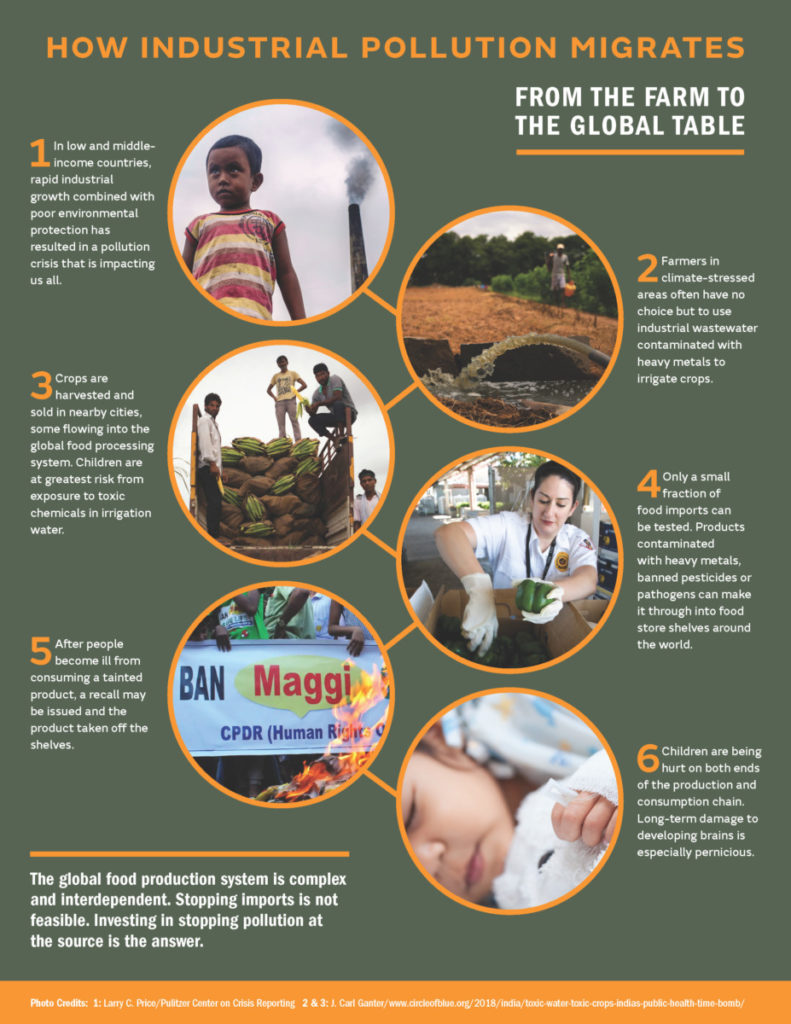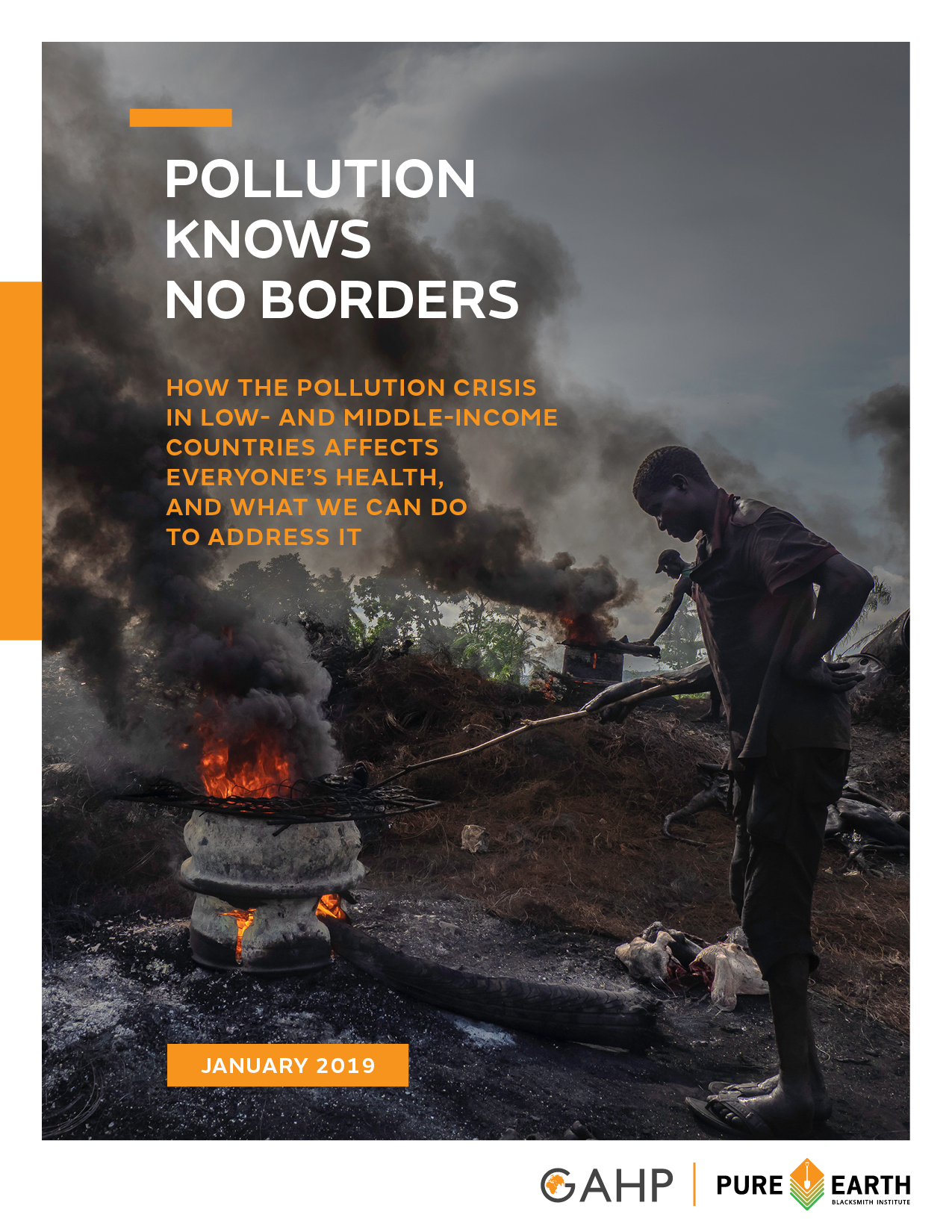When it comes to pollution, we are all connected. There is an invisible toxic thread that links workers being poisoned in poorer countries producing products, and consumers exposed to poisons while consuming these products. Reducing pollution is the right thing to do for children growing up in these countries, and it will also safeguard the health of children in wealthier consumer nations —Richard Fuller, President, Pure Earth
Think you’re not impacted by polluted places far from your home?
Our new report: Pollution Knows No Borders shows how toxic pollution travels from country to country, not only in the air and water, but also in the food and products we buy. We are all affected. We are all connected. Our children are the most vulnerable victims. Learn more about why this is one of the biggest health threats and what we can all do.
- Download the new report: Pollution Knows No Borders
- Read the press release
- Scroll below or click to see interactive map showing global trade flows.
From The Report:
- See how industrial pollution migrates from farm to global table
- Find out how much food we import from countries with high pollution levels
- How do you protect your family? Click here for resources or see the report.
Learn more:
- Read Scientific American’s editorial It’s Time to Get Arsenic and Other Toxic Substances out of Baby Food .
- U.S. smog can come from China? And other facts about pollution’s toxic travels.

Global briefing featured:
Richard Fuller President, Pure Earth
Jack Caravanos Director of Research, Pure Earth
J. Carl Ganter Co-Founder & Director, Circle of Blue
Gina McCarthy Former Administrator, EPA
Janez Potočnik Co-Chair of UN Intl. Resource Panel
Baskut Tuncak UN Special Rapporteur
Toxic pollution is invisible and often takes years before the health impacts become evident but it is one of the biggest health threats we face today. There are still many domestic sources of modern pollution but increasingly our exposure comes from low and middle-income countries. That’s why it’s in everyone’s interest to advocate that pollution be addressed at the source, wherever it is around the world.—Gina McCarthy, director, Center for Climate Health and the Global Environment, Harvard University; former Administrator, US EPA
Transboundary Pollution Map: Our interdependent world
(This interactive map is best viewed on Chrome. Click through the arrows to see the story of transboundary pollution unfold.)
Imported food products are an amalgam of ingredients originating in multiple countries. Many products have long supply chains. While the U.S., Canada and Europe have banned many toxic chemicals and pesticides, these harmful products continue to be used in factories and in agricultural production in low- and middle-income countries where environmental policies are less stringent.
Several studies have documented the increase in use of untreated industrial wastewater contaminated with toxic chemicals for crop irrigation by farmers lacking access to clean water. Constant exposure to this water sickens farmers and their families. The poisoned water permanently contaminates the soil, gets absorbed by the plants, and makes its way into global food markets, exposing consumers around the world.
- Independent testing of popular brands of chocolate between 2014 and 2018 found levels of lead and cadmium in 96 of 127 products for sale in US that exceeded California’s maximum allowable dose.
- An analysis of a frozen pizza found that it was made from 35 different ingredients that passed through 60 countries on five different continents.
- Your apple juice may be labeled “Product of Canada” but may have been made with concentrate from China.
- One study found rice teething biscuits and cereal had between 61 and 92 times higher levels of mercury, and nearly ten times more arsenic than products made with wheat/oats.
- Only a small percent of fish is tested for toxins by the US FDA – less than 1/10th of 1 percent. Yet of those tested, often 10 percent are rejected. Similar results occur for vegetables in Europe and elsewhere.
The solution is to prevent pollution at its source
Simply adding border controls does not work, as companies importing food and products above safe levels often just re-open with another name. Besides, air and water toxic transports are not stopped at a customs gate.
You can’t solve air pollution or transboundary pollution on a country-by-country basis. It requires global cooperation to deal with the problem at the source. The good news is that international efforts underway to combat climate change will greatly reduce air pollution and improve the health of children everywhere. —Janez Potocnik, Co-Chair of UN Intl. Resource Panel
Pesticides and chemicals known to be too risky to use in the US or Europe have long been exported in large quantities to poor countries that don’t have adequate standards of protection or ability to enforce existing standards. The exploitation of these double standards for production and consumption results in huge impacts on local communities in these countries and oftentimes widespread exposure of these toxics through the global environment and consumer products. —Baskut Tuncak, the UN Special Rapporteur on Human Rights and Toxics.
As wells in communities decline or become contaminated, farmers are forced to use alternative sources of irrigation water, such as industrial waste from mills and tanneries, and raw sewage from nearby cities to grow food for themselves and the world’s urban populations. —J. Carl Ganter, Managing Director of Circle of Blue
Banning a highly toxic chemical agent in a high-income country offers a imprecise and illusory sense of global safety. Many chemical agents are dynamic and move through the environment as simple as the wind blows… The world needs to come together and work unilaterally to remove these agents. —Dr. Jack Caravanos, Clinical Professor of Environmental Health Sciences, New York University; Head of Research, Pure Earth.


